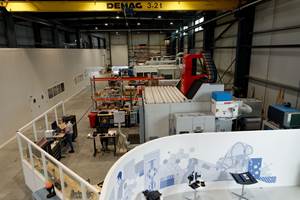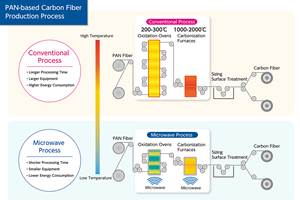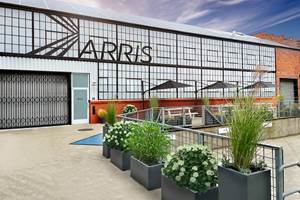Airbus Helicopters verify performance of 410km/h Clean Sky 2 demonstrator
X3-based, compound VTOL airframe configuration nears final design but exact use of composites yet to be detailed
Airbus Helicopters, Marignane, France, has achieved an important milestone in the development of the high-speed, compound helicopter demonstrator currently being built as part of the LifeRCraft Compound Rotorcraft Clean Sky 2 European research program. A mockup of the vertical takeoff and landing (VTOL) airframe design has now undergone windtunnel testing in an Airbus facility. The tests proved the viability of the chosen design’s efficiency, sustainability and performance, paving the way for a preliminary design review at the end of 2016. The overall project, meanwhile, has passed its first official milestone by reaching the end of its pre-design phase.
Building upon the achievements of Airbus Helicopters’ record-breaking X3 technology demonstrator, the Clean Sky-demonstrator will help refine the “compound” configuration and bring it closer to an operational design, aimed to meet future requirements for increased speed and better cost-efficiency, plus dramatic reductions in emissions and acoustic footprint. Flight-testing of the prototype is expected to start in 2019.
According to a stakeholder presentation in March 2015, development of the Clean Sky technology demonstrator is split between various Airbus Helicopters sites, with Donauwörth, Germany in charge of the main fuselage and wings, the Le Bourget, France blade facility handling main and lateral rotors, and the tail boom and its control surfaces prepared by its factory in Albacete, Spain. Overall project management, integration and ground- and flight-test activities will be carried out at the company’s headquarters. This same source indicated the fuselage should be made from advanced composites or a metallic/composite hybrid, with research contributed by Romania’s INCAS aerospace research agency (Bucharest).
According to a 2014 Airbus Helicopters presentation on the Clean Sky 2 LifeRCraft Compound Rotorcraft program, Airbus Helicopters has led the work package for design and manufacturing of an advanced wing structure for rotorcraft additional lift. That program also features a work package titled: Wing and Tail Unit Components Multifunctional Design and Manufacturing (including Out of Autoclave composites). LifeRCraft Compound Rotorcraft Airframe development was scheduled to start in Jan. 2015 and be completed in 5.5 years with critical design review at the end of 2016.
Airbus Helicopters has used composites in its rotorcraft for decades (see “Donauwörth as composites pioneer”), and reports it has tested natural flax fibers in hybrid composite materials on the X3 as part of environment and product life cycle improvements. With its partners, it is also assessing and developing solutions for recycling materials used to build current and future helicopters.
“We are honored to be carrying out this project on behalf of the Clean Sky Joint Undertaking and the large number of European companies who are taking part in the development. Our ambition is to become the benchmark of the rotorcraft industry, and as such we are willing to drive a bold vision for the future of helicopter transportation, said Jean-Brice Dumont, Airbus Helicopters Chief Technical Officer. “Our Clean Sky 2-demonstrator will not only be about going faster; it will help make speed smarter by seeking the best trade-off between cost-efficiency, sustainability and mission performance. We want to break the cost barrier usually associated with increased speed and range and pave the way for new missions for 2030 and beyond, by providing crucial emergency or door-to-door transportation services to European citizens where they need it most.”
Ron Van Manen, Clean Sky 2 Program Manager, highlighted that “The LifeRCraft Demonstrator project in Clean Sky 2 will pull together capabilities from across the European Research Area, addressing technology gaps in systems, structures and overall design and demonstrating the viability of a compound rotorcraft design . . . that will strengthen Europe’s already formidable competitive position in the vertical lift aviation sector."
For more on the US-based Future Vertical Lift program, see “Composites help Bell V-280 toward Future Vertical Lift” and “Sikorsky S97 RAIDER helicopter completes first test flight”.
Related Content
Plant tour: Daher Shap’in TechCenter and composites production plant, Saint-Aignan-de-Grandlieu, France
Co-located R&D and production advance OOA thermosets, thermoplastics, welding, recycling and digital technologies for faster processing and certification of lighter, more sustainable composites.
Read MoreMicrowave heating for more sustainable carbon fiber
Skeptics say it won’t work — Osaka-based Microwave Chemical Co. says it already has — and continues to advance its simulation-based technology to slash energy use and emissions in manufacturing.
Read MorePlant tour: Arris Composites, Berkeley, Calif., U.S.
The creator of Additive Molding is leveraging automation and thermoplastics to provide high-volume, high-quality, sustainable composites manufacturing services.
Read MoreHexagon Purus Westminster: Experience, growth, new developments in hydrogen storage
Hexagon Purus scales production of Type 4 composite tanks, discusses growth, recyclability, sensors and carbon fiber supply and sustainability.
Read MoreRead Next
Plant tour: Daher Shap’in TechCenter and composites production plant, Saint-Aignan-de-Grandlieu, France
Co-located R&D and production advance OOA thermosets, thermoplastics, welding, recycling and digital technologies for faster processing and certification of lighter, more sustainable composites.
Read More“Structured air” TPS safeguards composite structures
Powered by an 85% air/15% pure polyimide aerogel, Blueshift’s novel material system protects structures during transient thermal events from -200°C to beyond 2400°C for rockets, battery boxes and more.
Read MoreDeveloping bonded composite repair for ships, offshore units
Bureau Veritas and industry partners issue guidelines and pave the way for certification via StrengthBond Offshore project.
Read More

















.jpg;maxWidth=300;quality=90)








